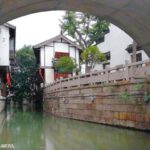Sanzhu Temple is located on the picturesque Fengxing Mountain to the south of Tianzhu Mountain in Anhui. From a topographical perspective, Sanzhu Mountain resembles a dancing colorful phoenix, with the temple situated beneath the phoenix’s neck. The temple was founded by the national teacher of the Southern Dynasty, Baozhi Zen Master, and was named Shangu Valley Temple by Emperor Wu of Liang. In the early Sui Dynasty, the Third Patriarch of Zen, Monk Sengcan, came here to spread the Dharma and teach. He passed on his robe and bowl to the Fourth Patriarch, Daoxin, and attained Nirvana here in 606 AD, hence the name Sanzhu Temple. Later, Emperor Suzong of Tang bestowed the temple the name Sanzhu Shangu Qianyuan Zen Temple. Emperor Daizong of Tang posthumously honored the Third Patriarch Monk Sengcan as Jianzhi Zen Master and named his stupa Jueji Tower. Emperor Taizong of Song honored the founding Zen Master Baozhi as Bao Gong and bestowed the title of Daolin Zhenjue Zen Master. The prestigious status of Sanzhu Temple attracted numerous literati and poets. During the Northern Song Dynasty alone, figures such as Lin Bu, Wang Anshi, Su Dongpo, Huang Tingjian, Li Gonglin, and Lu Zai visited the temple, composed poems, and some even resided in the temple to study, cultivate their character, and diligently practice Buddhism. A poem goes, “Who is the best in the Zen forest? This place is the crown of the Southern states.” The natural scenery and cultural landscapes around Sanzhu Temple blend harmoniously, complementing each other, with a changing view at every step, leaving one’s eyes hardly able to rest. To the east of the temple are the White Crane Peak, White Deer Ridge, and the ruins of the Zhenyuan Palace; to the south, the Jingjia Bridge and Wutang Morning Ferry on both banks of the Qianshui River are all within view; to the west, the Shangu Spring, the Stone Ox Ancient Cave, and the cliff inscriptions are still vividly before one’s eyes; to the north, Zhuoxi Peak and Chaotian Peak compete with Jueji Tower for beauty. Moreover, throughout the upper and lower parts of Sanzhu Mountain, ancient cypresses and pines are lush and verdant. Sanzhu Temple currently has several main halls, including the Mountain Gate Hall, the Ascension Stairs, the Heavenly Kings Hall, the Mahavira Hall, the Thousand Buddhas Hall, Jueji Tower, and the Patriarch Hall. Sanzhu Temple once attracted numerous dignitaries and nobility throughout the ages, leaving their true traces on the cliff walls of the Shangu Spring. The temple is open all year round from 6:00 to 18:00.
Sanzhu Temple
Sanzhu Temple is located on the picturesque Fengxing Mountain to the south of Tianzhu Mountain in An[...]









